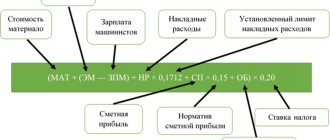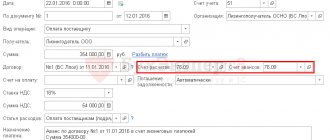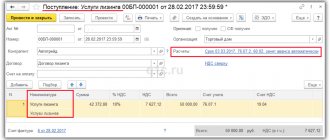Accounting for import transactions
In accordance with the Federal Law of December 8, 2003 No. 164-FZ “On the Fundamentals of State Regulation of Foreign Trade Activities” (as amended and supplemented) (clause 10 of Article 2), import of goods is the import of goods into the Russian Federation without the obligation to re-export .
To avoid problems with legislation, it is necessary to very scrupulously maintain both accounting and tax records of import transactions.
Accounting for import transactions is in many ways similar to tax accounting, but there are a number of distinctive features:
| Similarities | Differences |
| When determining the cost of goods, the costs incurred by the taxpayer when importing goods into the territory of the Russian Federation are taken into account. Actual costs can be classified as expenses when calculating the organization's income tax. | When calculating income tax, an organization has the right to write off expenses in any manner convenient for it. |
VAT refund when importing goods
VAT paid upon import can be deducted if the company has registered in the purchase book:
- customs declaration for imported goods;
- payment documents for VAT payment.
When forming a purchase book, you can take into account the recommendations given by the tax authorities of the Federal Tax Service of Russia for Moscow in letter No. 16-15/070201 dated July 5, 2010 and paragraph 17 of the Rules for maintaining a purchase book, approved by Decree of the Government of the Russian Federation No. 1137 dated December 26, 2011.
The organization can include the paid amount of VAT upon import, customs duty, customs fee as expenses, in accordance with subparagraph 22 of paragraph and subparagraph 11 of paragraph 1 of Article 346.16 of the Tax Code of the Russian Federation.
Features of accounting for VAT when importing goods from the EAEU countries are provided for in the Treaty on the Eurasian Economic Union, signed in Astana on May 29, 2014.
The EAEU union includes: the Russian Federation, Belarus, Kazakhstan, the Kyrgyz Republic and Armenia.
Accounting entries for accounting for import transactions
A detailed explanation of accounting and tax accounting for import transactions will be given below:
| Accounting entry | Explanation | Document confirming the operation | |
| D 60 | K 52 | Transfer of advance payment to the supplier for imported goods | Bank statement, payment order |
| D 76 | K 51 | Payment of customs duties | DT, bank statement, payment order |
| D 07 D 08-4 D 10 D 41 | K 60 K 76 | Ownership rights to goods as:
The owner makes an independent decision, guided by regulations. | Form No. OS-14 “Act of acceptance (receipt) of equipment” Form No. MX-1 “Act of acceptance and transfer of inventory items for storage” Form TORG-1 “Act of acceptance of goods” |
| D 19 | K 76 | Import VAT reflected | DT, bank statement, accounting certificate |
| D 07 D 08-4 D 10 | K 60 | Costs of delivering property to the territory of the Russian Federation | Accounting information |
| D 19 | K 60 | VAT on property transportation | Invoices, accounting certificates |
| D 01 | K 08-4 | Capitalization of received property | Form No. OS-1 “Act of acceptance and transfer of fixed assets (except for buildings, structures)” |
| D 68 | K 19 | Submitting import VAT for deduction | Invoice, accounting certificate |
| D 60 | K 91-1 | Accrual of positive exchange rate differences on settlements with suppliers in foreign currency | Accounting information |
| D 91-2 | K 60 | Accrual of negative exchange rate differences on settlements with suppliers in foreign currency | Accounting information |
| D 60 | K 52 | Final payment to the supplier for the imported goods | Bank statement |
Transfer of an advance to a foreign supplier
List the advance payment using the document Write-off from the current account, transaction type Payment to supplier in the Bank and cash desk section – Bank – Bank statements.
Please indicate:
- Bank account - foreign currency bank account in EUR;
- VAT rate - Without VAT .
Postings
Tax accounting of import transactions
According to paragraph 3 of paragraph 1 of Article 268 of the Tax Code of the Russian Federation, when selling property or property rights, the taxpayer has the right to reduce income from such transactions by the amount of expenses directly related to such sale.
The following expenses are accepted for accounting: (click to expand)
- at the rate;
- storage;
- service;
- transportation.
In accordance with Article 320 of the Tax Code of the Russian Federation, the procedure for determining expenses for trade operations is determined. According to this normative act, the amount of distribution costs includes expenses for:
- delivery of goods;
- warehousing costs;
- other expenses associated with the purchase of goods.
The taxpayer has the right to determine the cost of goods taking into account distribution costs. The formation of the cost of goods is explained in detail in the section “How is the cost of imported goods formed?”.
Example of accounting for import transactions
ABC LLC purchased goods in Spain for the amount of €8,000 on July 11, 2017. ABC LLC received property rights to the goods on July 11, 2017.
- Customs duty – 12,000 rubles.
- Customs duty – 15%.
- Calculated VAT: 8000*68.77*1.15*0.18=113883.12 rubles.
- Costs for delivery of property to the territory of the Russian Federation 34650.00 (including VAT 6237.00)
On July 16, 2017, the final payment for the goods was made. € exchange rate: 07/11/2017 – 68.77 rubles, 07/16/2017 – 68.36 rubles.
| Accounting entry | Explanation | Amount (rub.) | |
| D 76 | K 51 | Payment of customs duties | 12 000,00 |
| D 76 | K 51 | Payment of customs duties | 82 524,00 (8000*68,77*0,15) |
| D 07 D 08-4 D 10 D 41 | K 60 K 76 | Ownership rights to goods as:
The owner makes an independent decision, guided by regulations. | 550 160,00 (8000*68,77) |
| D 19 | K 76 | Import VAT reflected | 113 883,12 |
| D 07 D 08-4 D 10 | K 60 | Costs of delivering property to the territory of the Russian Federation | 34 650,00 |
| D 19 | K 60 | VAT on property transportation | 6 237,00 |
| D 01 | K 08-4 | Capitalization of received property | 550 160,00 |
| D 68 | K 19 | Submission for VAT deduction | 120 120,12 (113 883,12+6237) |
| D 60 | K 91-1 | Accrual of positive exchange rate differences on settlements with suppliers in foreign currency | 3 280,00 (8000*(68,77-68,36)) |
| D 60 | K 52 | Final payment to the supplier for the imported goods | 546 880,00 (8 000*68,36) |
Transfer of payment to customs
List the customs payment in the document Write-off from the current account type of transaction Other settlements with counterparties in the Bank and cash desk section - Bank - Bank statements.
The transfer of customs payments can be made in two payments: one for the payment of VAT and customs duties, the second for the payment of duties. This is due to the use of different BCCs when processing payments.
Read more Payment of VAT at customs when importing from third countries
But the overall filling will be the same:
- Agreement - basis for settlements, Type of agreement - Other ;
- Settlement account - 76.09 “Other settlements with various debtors and creditors.”
VAT and tax
Postings
Duty
Postings
Errors in accounting for import transactions
When accounting for import transactions, you must be very careful to avoid errors that are often identified during an audit:
- incorrect conversion of foreign currency into rubles when conducting a foreign exchange transaction;
- there is no translation into Russian of the text of the document on the basis of which payment is made from a foreign currency account;
- failure to meet deadlines for fulfilling obligations under contracts that provide for advance payments;
- incorrect correspondence of invoices for accounting of import transactions.
Acceptance of VAT paid at customs for deduction
Accept VAT for deduction using the document Generating Purchase Ledger Entries in the Operations - Period Closing - Regular VAT Operations section.
Clicking the Fill will automatically display the data on accrued VAT at customs. But to correctly fill out the purchase book, make adjustments.
By default, the columns Doc. No. payment and date of doc. payments are hidden. If you are deducting VAT on imported goods, then make sure that these columns are filled out correctly: they should reflect the payment details for the payment of “import” VAT to the budget.
See also: How can an importer set up and complete this document?
VAT was paid by payment order No. 100 dated March 27, 2018 (column 47 “Calculation of payments”, payment type 5010).
This means that in order for the correct tax payment details to be indicated in the purchase book, make adjustments to the document by indicating the number and date of the payment order only for VAT - No. 100 dated 03/27/2018.
During the work process, the accountant may need to clarify and refill this document. To avoid having to repeat manual adjustments, create a separate document only to offset the VAT paid at customs. In the Comment , place a corresponding note, for example, Import .
Postings
Documents required for registration of imported goods
According to the Federal Law of December 6, 2011 No. 402-FZ “On Accounting” (Article 9), each fact of economic activity must be subject to registration with a primary accounting document. To account for import transactions, the primary accounting documents, the presence of which is necessary for accounting and tax accounting of imported goods, are:
- foreign trade contract with the importer of goods;
- invoice issued by the seller;
- transport, forwarding documents;
- insurance documents;
- declaration of goods (DT);
- bank certificates confirming payment of customs duties and taxes;
- invoices, acts of acceptance of inventory items;
- technical documentation.
Accounting and tax accounting of imports: subtleties, nuances and typical mistakes
13.08.2019
Import provides the opportunity to import products from foreign manufacturers into the country for subsequent resale. But before releasing goods to the market, the importer will have to resolve many administrative and bureaucratic issues. He will try to sort out the latter today.
Current Russian legislation excludes the application of re-export obligations to imports. All foreign economic transactions upon their implementation must be properly reflected in the accounting and tax records of the importer. Accounting is carried out according to general rules, but has some specifics.
Capitalization of imports
Each operation within the framework of foreign economic activity involves accounting for:
- cost of imported goods;
- current taxation.
According to the Tax Code requirements, imports are credited at the cost of acquisition. It includes cost, import duties and customs duties.
What makes the process of recording imports specific is the expression of value in foreign currency. It is important to correctly convert the current amount into national currency. According to Russian accounting rules, the cost of imports in accounting databases and reporting documents must be displayed in rubles. To avoid errors, you must use the official rate of the Central Bank on the date of arrival. Another specific accounting nuance is related to exchange rate differences. The importer is not insured against either positive or negative consequences.
The date of arrival of imported goods is determined as the date of shipment of products from the warehouse of the foreign supplier. There is another option. The date of arrival is the date of registration of the customs declaration.
Formation of import cost
According to the current PBU, imported goods from the importer are accepted for accounting at actual cost. Its correct definition is reliable insurance against calculation errors and tax problems.
The specifics of determining the cost of imported products are due to the presence of various payments expressed in foreign currency and the splitting of payments to the supplier. For example, when determining the cost of goods for which an advance payment has been made, the exchange rate on the date of the advance payment is used. In the part that is not covered by the prepayment, when calculating the cost, the exchange rate on the date of registration of the goods is applied.
An important point: the debt to a foreign supplier for goods accepted for accounting is subject to revaluation. The latter is carried out monthly and on the date of its repayment. In both cases, exchange rate differences arise. They should be recorded as non-operating expenses or income.
The only case when exchange rate differences do not arise is full payment for imported goods in advance.
Accounting entries
Practical accounting of imports does not present any difficulties, since it is carried out according to a universal scheme. For each transaction, the accountant makes standard entries. The accounting reflects:
- settlements with the supplier (the fact of transferring payment for products to a foreign company);
- payment of customs duties;
- payment of import VAT;
- import receipt;
- posting of goods;
- inclusion of customs duties and taxes in the cost of imports;
- costs of delivery, customs clearance;
- VAT deduction;
- exchange difference.
Typical mistakes of a foreign trade accountant
Import accounting is specific, which complicates the work of an accountant. As for mistakes, most often specialists make them at the stage:
- Determination of the ruble equivalent of the cost of imported products expressed in foreign currency.
- Performing postings. The most common mistake here is combining operations. Each of them must be reflected in a separate posting. It is recommended to pay special attention to the reflection of exchange rate differences. Negative and positive differences are recorded in separate entries.
It should be noted that another fairly common mistake made by a foreign trade accountant when accounting for imports is recording transactions if there are certain questions about the supporting documents. The quality of primary accounting for foreign economic activity and internal operations must be standard. Otherwise, problems during a tax audit cannot be avoided.
Customs duties and import taxation
The importer's accountant has to calculate and transfer several types of payments to the budget. Mandatory for imports are: excise taxes, VAT, customs duties (compensatory, special, anti-dumping, import), customs fees for clearance, storage, and maintenance of products.
Not all listed payments may be relevant for a specific transaction. Their list is compiled for each HS code separately. As for paying the fees, the taxpayer has 15 days from the moment the import crosses the border. You can transfer payments to the budget before, as well as at the time of completing the customs declaration. The calculation of contributions is carried out on the basis of the customs value of goods, which is determined by the customs authority or the declarant.
When talking about import taxation, it is logical to start with VAT. The tax base for it, according to the Tax Code of the Russian Federation (Article 160), is determined based on the customs value of imported products, customs duties and excise taxes (if they are relevant). Most often, import VAT is transferred to the account of the customs authority. Directly when the importer becomes obligated to pay tax, the amount is written off. In accounting, transactions with import VAT are reflected in the corresponding entries.
Importers using OSNO who do not benefit from VAT exemption can deduct the amounts paid. However, for this to happen certain conditions must be met. The Tax Code of the Russian Federation (Article 171) provides for a tax deduction only if imported goods are used in taxable transactions.
The use of special tax regimes does not relieve importers of the obligation to transfer import VAT to the budget. Such taxpayers cannot claim tax as a deduction. They take VAT into account in expenses.
Import taxation has a number of features if the taxpayer uses the simplified tax system. The simplified tax must include customs costs and paid import VAT in the price of the goods. When the object of taxation is “income minus expenses,” these costs can reduce the tax base as imported goods are sold. But at the same time, settlements with the foreign supplier must be completed (Tax Code of the Russian Federation, Article 346). If the importer imported not products, but OS, VAT is not taken into account as expenses. It is included in the cost of the fixed asset.
Exchange rate differences are not taken into account under the simplified tax system if we are talking about currency revaluation (TC, Article 346.17).
Import accounting also has many other features. To take them all into account, an accountant must have the appropriate competencies, regularly improve their qualifications, and monitor changes in currency and tax legislation.
It is not necessary to hire a specialized specialist. It is rational to outsource accounting of foreign trade activities. This allows not only to effectively implement the function, but also to obtain guarantees of the quality of accounting, the correctness of calculations, and the correctness of declarations.
Category “Questions and Answers”
Question No. 1. Are we required to make advance payments to a foreign seller when purchasing imported goods?
The obligation to pay an advance payment arises provided that this obligation appears in the contract that you have concluded with the foreign supplier. If the contract does not provide for an advance payment when purchasing imported goods, you are not obliged to pay it.
Question No. 2. Do I understand correctly that accounting for goods begins on the day the property rights to them are transferred, even if the goods have not yet been received and paid for?
Yes, in accordance with the legislation of the Russian Federation, the buyer of imported goods accepts the goods for fixed assets or inventories at the time of transfer of property rights from the seller.
Customs value of goods
The customs value of a product is the value that is the basis for calculating taxes and customs duties.
It largely depends on the conditions and characteristics of the delivery, as well as the specifics of the goods being supplied. In accordance with the Agreement on Determining the Customs Value of Goods Moved Across the Customs Border of the Customs Union (hereinafter referred to as the Agreement), the basis for its determination should be the transaction value (to the maximum extent possible) with these goods. That is, the price actually paid or payable for these goods when they are sold for export to the single customs territory of the Customs Union..
Articles 2 and 4 of the Agreement
At the same time, the Agreement establishes that when determining the customs value, expenses are added to the price actually paid (to be paid) for goods in the amount in which they were made (to be paid) by the buyer, but are not included in the price actually paid or payable for imported goods:
- remuneration to intermediaries (agents) and brokers associated with the purchase of valued (imported) goods;
- costs of packaging (if it is considered as a whole with imported goods);
- packaging costs, including the cost of packaging materials and packaging labor.
In addition, the customs value may include the appropriately distributed value of goods and services directly or indirectly provided by the buyer to the seller.
The customs value may include the following goods and services directly or indirectly provided by the buyer to the seller free of charge or at a reduced price for use in connection with the production and sale for the export of the valued (imported) goods into the single customs territory of the Customs Union, in an amount not included in the price, actually paid or payable for imported goods:
a) raw materials, materials, parts, semi-finished products and similar items that make up the imported goods;
b) tools, stamps, molds and other similar items used in the production of imported goods;
c) materials used in the production of imported goods;
d) design, development, engineering, design work, decoration, design, sketches and drawings made outside the single customs territory of the Customs Union and necessary for the production of imported goods;
3) part of the income (revenue) received as a result of subsequent sale, disposal in another way or use of imported goods, which is directly or indirectly due to the seller;
4) costs of transportation (transportation) of goods to the airport, seaport or other place of arrival of goods to the single customs territory of the Customs Union;
5) expenses for loading, unloading or transhipment of goods and carrying out other operations related to their transportation (transportation) to the airport, seaport or other place of arrival of goods to the single customs territory of the Customs Union;
6) insurance costs in connection with the operations specified in subparagraphs 4 and 5 of paragraph 1 of this article;
7) license and other similar payments for the use of intellectual property (including payments for patents, trademarks, copyrights) that relate to the goods being valued (imported) and which the buyer directly or indirectly made or must make as a condition for the sale of the goods being valued, in an amount not included in the price actually paid or payable for those goods.
Art. 5 Agreements
Postings and operational accounts for customs duties for exports
What are wiring? This is an accounting term that means recording various changes in the condition of a particular product in the documentation.
To what account should customs payments be attributed when exporting products? When exporting goods outside the territory of the state, the procedures are written off from account 90, subaccount 5 to account 76. The procedure is documented by posting D90/5 K76.
As a rule, when exporting products, the VAT rate is 0%. In other words, the foreign trade participant receives compensation from the state budget for repayment of this payment. But there are some exceptions for such cases:
- sales and delivery of products are carried out in the Republic of Belarus;
- export of petroleum products.
To receive reimbursement for VAT expenses, you must provide the government agency with the following basic documents:
- a contract concluded between a foreign trade participant and a foreign representative;
- a document from a banking organization confirming a financial transaction;
- cargo customs declaration.
The payer must comply with the deadlines for submitting documents. They are 180 days after drawing up the declaration.
After submitting the required package of documents to the customs authority, VAT refund is carried out within 3 calendar months.
Export duties in the income statement | "Garant-Service" Smolensk
Since 2011, export customs duties have not reduced the amount of revenue. They should be included in selling expenses. This means that exporters no longer have the right to apply subaccount 90-5 “Export duties”. Revenue is reduced only by VAT and excise taxes.
In anticipation of the preparation of annual financial statements, we recommend that you once again clarify your accounting policies to ensure their compliance with the new rules in force since 2011. We draw the attention of companies receiving income from export contracts to one of these nuances.
Change in income statement
Let’s compare the “Revenue” lines of the profit and loss statements according to the old form * (1) and the new form * (2). The company's predecessor was used in 2010. And throughout 2011, accountants used a new form in interim reporting.
The previous report proposed to reflect revenue minus VAT, excise taxes and similar mandatory payments.
In this part, the order of the Ministry of Finance of Russia dated July 22, 2003 N 67n corresponded to paragraph 23 of PBU 4/99 “Accounting statements of an organization” * (3). This approach is supported by the Instructions for the Application of the Chart of Accounts*(4). In order to record the amounts of export duties, subaccount 90-5 “Export duties” is provided for account 90 “Sales”. But neither PBU 4/99 nor the Instructions are regulatory legal acts on accounting, since they do not have a state registration number with the Ministry of Justice of Russia * (5).
Nevertheless, export duties really needed to be excluded from revenue due to the direct indication of paragraphs 3 and 5 of PBU 9/99 “Organizational Income” * (6).
Meanwhile, in the new report, note 5 is given to the line “Revenue” (code 2110): “Revenue is reflected net of value added tax and excise taxes.” As you can see, only indirect taxes need to be excluded from revenue. And export duties are not recognized as taxes *(7).
Therefore, in terms of export duties, Note 5 formally conflicts with PBU 9/99. And we are faced with mutually exclusive rules of regulatory legal acts of equal legal force (both were introduced by orders of the federal executive body). In a situation of conflict of norms, the act that came into force later has priority*(8).
So, in the income statement for 2011, exporting companies should not reduce revenue by the amount of export duties.
The new report form, like the old one, contains two columns, one of which reflects the indicators of the reporting year, and the other - the previous year. These data must be comparable*(9). Consequently, revenue for 2010 must also be shown without deduction of export duties. And their amount must be included in the company’s business expenses.
What do customs duties include?
Customs duties are a general concept that is used to summarize financial transactions and payments when exporting or importing goods.
What does this concept include? Having a problem? Call our customs specialist:
Moscow and region (call is free)
Saint Petersburg
Fees
Customs duties are a mandatory payment for all participants in foreign trade. It is levied by government agencies when exporting or importing products across state borders.
The main duties for foreign trade participants include:
- Imported.
- Exportable.
Customs fees
Such payments are charged in the following cases:
- as a fee for processing the product at customs;
- for the presence of products in a customs warehouse;
- for customs escort, etc.
Customs duties are paid when exporting or importing goods.
Excise taxes
Such fees are charged when transporting products and consumer goods, the list of which is established by the Legislation of the Russian Federation.
Article 181 of the Tax Code contains all the necessary information about excisable products.
VAT
VAT - value added tax. This payment must be made before the products are released from customs. The following indicators are used to calculate VAT:
- customs value of transported products;
- excise tax;
- current rate;
- the amount of customs duty that is payable.
To calculate value added tax, you need to add up the cost of the product, excise tax and duty. The resulting number must be multiplied by the current bet.
What does not apply to customs duties?
Payments collected from participants in foreign economic activity:
- Special . Some goods imported into the country may negatively affect domestic production, reducing its profitability. This type of duty protects Russian manufacturers from bankruptcy.
- Anti-dumping . They prevent the sale of goods brought from abroad at dumping prices.
- Compensatory . They are levied only when subsidies were used in the production or transportation of products.
Collection of these types of duties is carried out in a special manner in accordance with the current Legislation.





